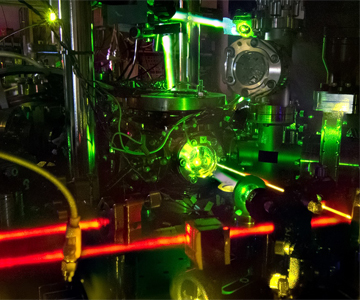
One of NIST’s ytterbium-lattice atomic clocks. NIST physicists combined two of these experimental clocks to make the world’s most stable single atomic clock. [Image: N. Phillips/NIST]
In line with the maxim that “two is better than one,” scientists at a U.S. laboratory have built a dual-ytterbium-cell optical clock that sets a new record for frequency stability (Nature Photon., doi:10.1038/nphoton.2016.231). By coupling two clocks into one system, the researchers eliminated a source of aliasing noise that had dogged efforts to improve ultraprecise experimental timekeepers.
Back from the dead
This noise, known as Dick noise, results from “dead time,” which occurs between the periods when the clock’s laser is probing trapped atoms. During the dead time, however, the laser and atoms are not synchronizing with each other. The periodic probing ends up aliasing the fluctuations of the laser’s frequency at certain harmonics.
By interleaving the alternating probe cycles of the two cold-ytterbium optical clocks, the team at the U.S. National Institute of Standards and Technology (NIST) eliminated the dead time of the overall timekeeping system. That system's overall frequency instability was measured at 6 x 10–17 τ–1/2, where τ is the averaging time.
For their experimental setup, the NIST scientists used a single quantum-dot laser operating at a wavelength of 1156 nm and stabilized to a reference cavity. After frequency doubling to 578 nm, the beam was divided in two and directed to two optical lattice traps, which contained 5,000 and 10,000 ytterbium atoms respectively.
Limiting the limitation
In addition to boosting frequency stability, suppressing the Dick noise provided a second benefit: the zero-dead-time clock can reach an instability level of 1 x 10–18 after only a few thousand seconds of operation. That’s roughly an order of magnitude faster than previous clock experiments.
The NIST team suggested several possibilities for future reductions in quantum projection noise, which is another source of clock instability. The authors also expressed hope that the increased simplicity of the zero-dead-time clock may give it more widespread applications, such as tests of fundamental physics.
